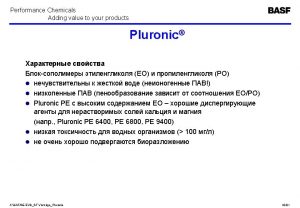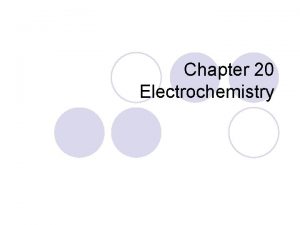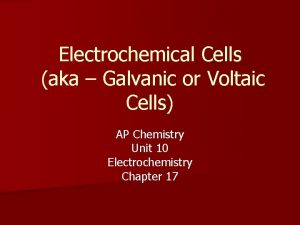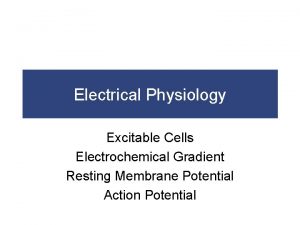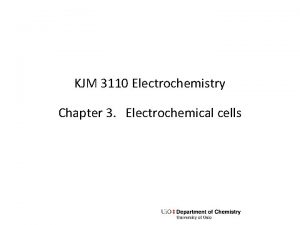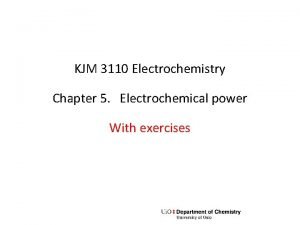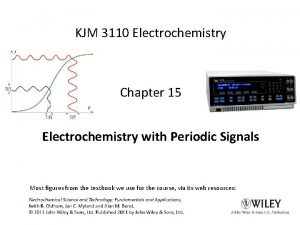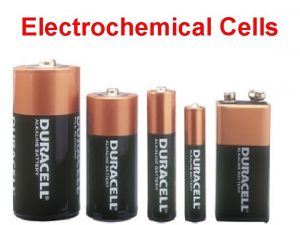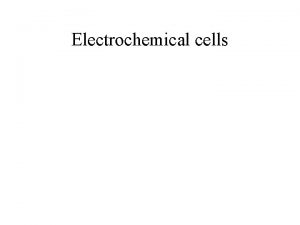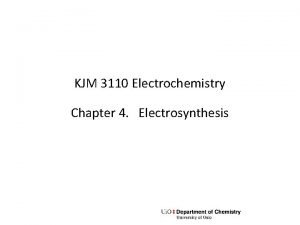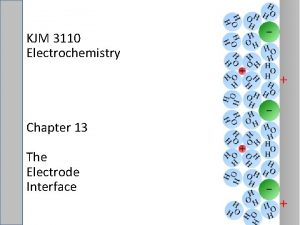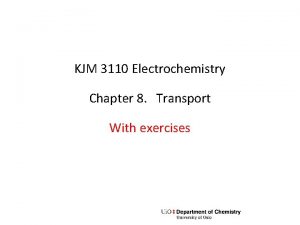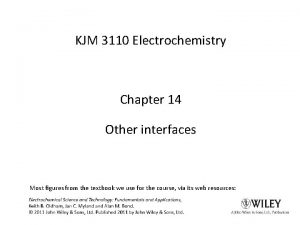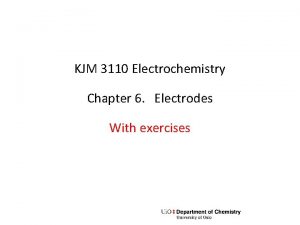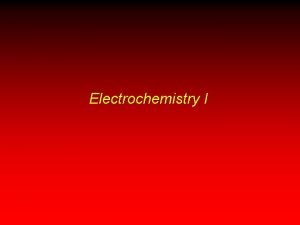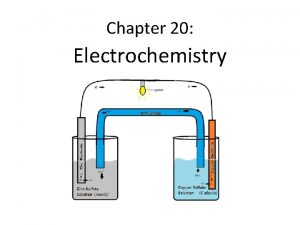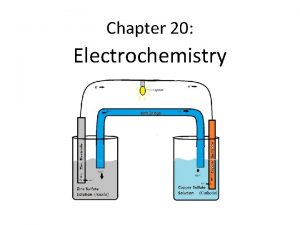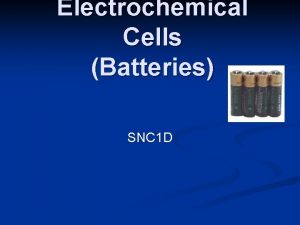KJM 3110 Electrochemistry Chapter 3 Electrochemical cells With
































- Slides: 32

KJM 3110 Electrochemistry Chapter 3. Electrochemical cells With exercise slides

Recap from Ch. 1 Electricity • In Chapter 1 we familiarised ourselves with the most fundamental concepts of electricity itself. • Charge Different disciplines, textbooks, articles, teachers use different symbols for many of these entities. For instance, e vs q, q vs Q, f vs F, U vs E, i vs I… • Electrostatic force • Electrical work We could try to be completely consistent here. • Potential and voltage • Capacitance Instead we allow variations, to train ourselves for reality, but aim to always define and/or • Current make clear what we mean. • Conductance and resistance • DC and AC voltage and current and impedance

Remaining parts of Ch. 1 we considered non-mandatory for now • Electrical circuits • Models of electrochemical behaviour • AC signals • AC impedance, Fourier transforms • Real and imaginary contributions, loss, and power dissipated

Ch. 1 Summary – four selected important concepts • Charge and field • Charge capacitance of insulator (dielectric) • Current transport in a conductor • Conductivity

A brief look at Chapter 2 Chemistry; Concepts

A brief look at Chapter 2 Chemistry; Summary

Electrochemical cells Lead-acid cell as example

The lead-acid cell – half and full cell reactions Positrode Negatrode Total, chemical, cell reaction Total, electrical

The lead-acid cell – Gibbs energy change The activity of pure condensed phases is defined as unity. Hence, for instance a. Pb(s) = 1

Exercise • Use data from the table on page 391 in the textbook to confirm the value of the ΔG 0 reported on the previous slide (equation 3: 8).

The lead-acid cell – electrical work and cell voltage Electrical work w = ΔG (J) = -neΔE W = NAw = ΔG (J/mol) = -n. FΔE

The lead-acid cell – cell voltage

Exercise – cell voltage • On pages 58 -59, the text book explains pointwise how to calculate a cell voltage based on half cell reactions and tabulated standard data. • This should be known from physical chemistry. • However, it is good to practice. The book, in footnote 309 suggests: • What is Web#309?

Exercise – cell voltage • Read the text at the bottom of the previous slide. • Draw the cell, and expand it to the left and right, so that copper becomes an additional phase on both sides. • Draw potential lines through the cell, similar to those of Figure 1. 9 in the text book, but now also including the copper that the voltmeter eventually measures the voltage between. (We draw this one without current running (open circuit), and hence there need not be a gradient through the electrolyte – it can be flat. ) • Does the text make sense? Or rather, how do you make sense out of the text in view of the figure or vice versa?

The lead-acid cell – standard state Standard state: All activities = 1 Temperature can, but need not be, 298. 15 K This is not equilibrium, it is the standard state

The lead-acid cell – equilibrium From Ch. 2: Now becomes: Important to understand this

Exercise - equilibrium • Work two and two: • One explains the equations below to the other: • The other explains the following equation in return:

The lead-acid cell – galvanic operation Galvanic cell: The chemical potential differences – the spontaneous change according to ΔG – drives the cell. Battery under discharge Fuel cell Cathode (positrode) Anode (negatrode)

Exercise – galvanic operation • Draw the same cell as before, with potential lines. • Indicate the direction of current in galvanic operation. • The current leads to voltages (overpotentials) building up due to resistances in the electrolyte, interfaces (kinetics), and electrode phases. Are you able to include such voltages so that they all contribute to decrease the cell voltage?

The lead-acid cell – electrolytic operation Electrolytic cell: The applied electrical potential difference drives the cell against the spontaneous change according to ΔG. Battery under charge Electrolyser Anode (positrode) Cathode (negatrode)

Exercise – electrolytic operation • Draw the same cell as before, with potential lines. • Indicate the direction of current in electrolytic operation. • The current leads to voltages (overpotentials) building up due to resistances in the electrolyte, interfaces (kinetics), and electrode phases. Are you able to include such voltages so that they all contribute to increase the cell voltage?

Electrochemical cells – three modes of operation Polarisation curve for a lead-acid cell aka Open Circuit Voltage (OCV)

Exercise – galvanic operation • In the graph, the voltage changes from the OCV when current runs galvanically or electrolytically. Does this fit qualitatively with what you have been drawing in the previous two exercises? • A footnote in the textbook says about a cell at open circuit: “It can be argued that the cell is not at equilibrium; however, each of the electrodes is at equilibrium. ” • Discuss what is meant by this.

Electrochemical cell and an «impractical» cell…. ?

Exercise • Can the last of the figures in the previous slide give rise to an idea of anything useful this cell can do?

Cells with junctions – The Daniell cell Self study and check – this and Eqs. 3. 20 -3. 23 is standard from general and physical chemistry. What goes on at the diaphragm under open circuit and under galvanostatic conditions?

Exercise – The Daniell cell • Self study and check: Eqs. 3. 20 -3. 23 is standard from general and physical chemistry. • What goes on at the diaphragm under open circuit and galvanic conditions? • Express the Gibbs energy of each reactant and product of the total reaction in terms of standard Gibbs energy and activities, using the equations in the summary from Ch. 2. • Sum them to obtain the Gibbs energy change of the total reaction. Collect the standard energies to a standard Gibbs energy change for the reaction, and the activity terms to form the reaction quotient. • What is the cell voltage of the Daniell cell under standard conditions and what does standard conditions mean? • If we increase the concentration of solutions on both sides 10 -fold, what happens with the cell voltage? • If you want to increase the cell voltage of a Daniell cell, how could you do that? • If you want to use a Daniell cell as an energy source, how could you assemble it to maximise the energy it can give?

Electrolyte junctions - liquid junctions Junction potentials arise from different mobilities µ and charges z for anions and cations. KCl(aq) gives almost zero junction potential

Another solution – bipolar electrodes We may consider to discuss this as part of our colloquium….

Semipermeable and solid electrolyte membranes • Semipermeable membranes • Selective permeation • Allows recharging without e. g. cation intermixing • Adds resistance • Solid electrolyte membranes • E. g. Y-stabilized Zr. O 2 (YSZ) • Selective transport • Proton conducting solids. Other ions?

Summary Ch. 3 Electrochemical cells • Equilibrium • I=0 • Galvanic operation • I>0 • Electrolytic operation • I<0

Exercise 1. Find the Ecell of the acid lead battery from the electrochemical series 2. Find the Ecell of the Daniell cell when [Zn 2+]=1 x 10 -6 M 3. Molecular oxygen cannot oxidize Mn. O 2 to permanganate anions via the reaction 4 Mn. O 2(s) + 3 O 2(g) + 4 OH- → 4 Mn. O 4 -(aq) + 2 H 2 O(l) E 0 cell = -0. 20 V Calculate the Ecell under non standard conditions and decide if the oxidation will happen spontaneously or not when p. H = 10, p. O 2 = 0. 20 atm, [Mn. O 4 -] = 1 x 10 -4 M and T = 25 °C
 Nondisjunction in meiosis
Nondisjunction in meiosis Pluronic pe 10100
Pluronic pe 10100 Occaml
Occaml 631-828-3140
631-828-3140 What is the 8-bit unsigned binary result of 5610 − 3110?
What is the 8-bit unsigned binary result of 5610 − 3110? Boletin 3110
Boletin 3110 Ap chemistry chapter 18 electrochemistry test
Ap chemistry chapter 18 electrochemistry test Chapter 20 review electrochemistry
Chapter 20 review electrochemistry Chapter 20 review electrochemistry
Chapter 20 review electrochemistry Chapter 21 electrochemistry
Chapter 21 electrochemistry Voltaic vs electrolytic cell
Voltaic vs electrolytic cell Chapter 20 electrochemistry
Chapter 20 electrochemistry Olfactory groove keros classification
Olfactory groove keros classification Tubular reabsorption
Tubular reabsorption Parafollicular
Parafollicular Somatic cells vs gametes
Somatic cells vs gametes Somatic cells vs germ cells
Somatic cells vs germ cells Chlorocruorin
Chlorocruorin Ghonarea
Ghonarea Venn diagram plant vs animal cells
Venn diagram plant vs animal cells Prokaryotic vs eukaryotic cells venn diagram
Prokaryotic vs eukaryotic cells venn diagram Cell organelle jeopardy
Cell organelle jeopardy Masses of cells form and steal nutrients from healthy cells
Masses of cells form and steal nutrients from healthy cells Younger cells cuboidal older cells flattened
Younger cells cuboidal older cells flattened Cuál es la diferencia entre la célula animal y vegetal
Cuál es la diferencia entre la célula animal y vegetal Are red blood cells prokaryotic or eukaryotic
Are red blood cells prokaryotic or eukaryotic Cell substance
Cell substance Cathode vs anode equation
Cathode vs anode equation Electrochemical deposition
Electrochemical deposition Electrochemical theory of corrosion
Electrochemical theory of corrosion Electrochemical machining animation
Electrochemical machining animation Refractory period anatomy
Refractory period anatomy Electrochemical series
Electrochemical series

